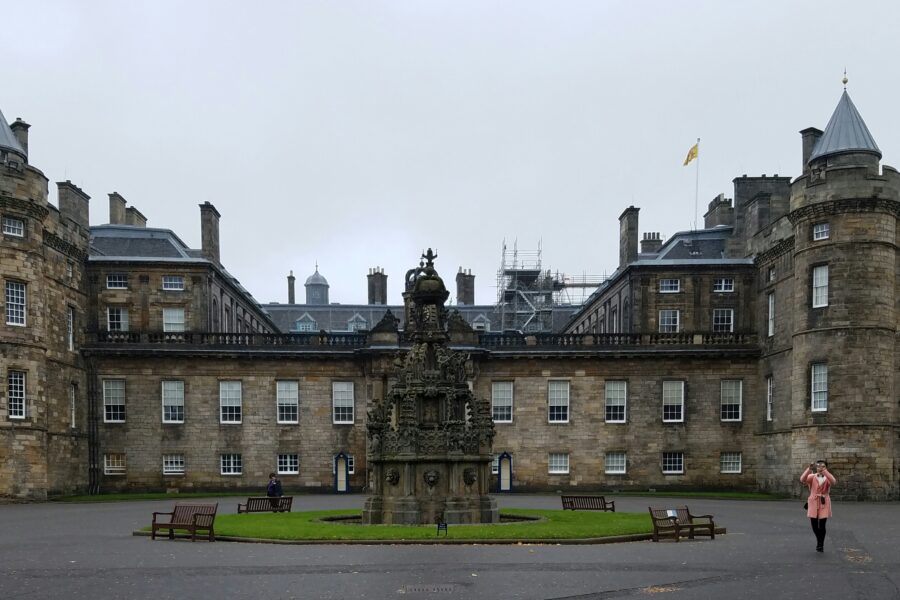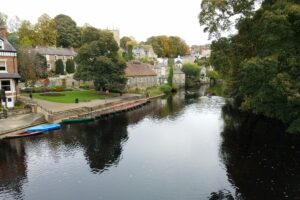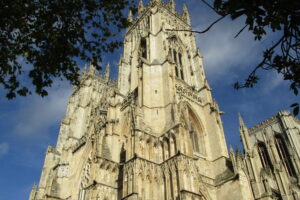It is misting heavily as we make our way across the wide cobbled courtyard to Holyrood’s entrance. We do as much as we can to shake the water and scrape the mud from our shoes before ascending the wide staircase which begins our tour. The best thing is that it we can walk and look and listen at our own pace.
Founded by David I as an Augustinian monastery in 1128, it grew and prospered through the centuries. Although frequently visited by Kings and dignitaries, it wasn’t a royal residence till 1501 when Mary Queen of Scots grandfather James IV built a palace in preparation of his marriage to Margaret Tudor—Henry VIII’s sister.

At the entrance we are confronted with a centuries old wide stone staircase and whitewashed walls hung with full size portraits of centuries old individuals. Being here, realizing its age, I’m not sure how glitzy ever wormed its way into my imagination. Holyrood is the oppressive stereotypical image made real that I have always had of a castle in this cold North Country.
Upstairs, the dark paneled walls create an ominous gloom on this gray and dismal day. Proceeding from room to massive room, with oriental carpets equal in size to the enormous scale, I see equally massive tapestries gracing many of the walls. Listening to the audio guide I hear that they were hung to help soften the hard edges of the dwelling by one of its royal occupants.
The story of the castle and its furnishings range from kings and queens named James, there were three—the IV Mary Queen of Scott’s grandfather, the V her father, and the VI her son, who was also James I of England and the first King of all Great Britain—to Mary herself, to the Charles’s, the George’s, to Victoria—not all in that order—and ending with today’s monarch, Elizabeth II. My head spins trying to keep them all straight. It is impossible. Much of the narrative concerns Mary and her ill fated life and death. I always imagined her as an austere middle-aged woman warring with her cousin Elizabeth I. That was only vaguely correct.

By the time Mary was barely eighteen years old she had lost both of her parents, become Queen of Scotland, Queen of France and was widowed. She ascended the throne six days after her birth when her father James V died. Her French mother sent Mary to the court of France when she was six years old as the betrothed to the Dauphin Francis. Seventeen short months after their marriage the young King of France fell ill and died. Unwilling to stay in France and live under the domination of her mother-in-law Catherine De Medici, Mary a Catholic, decided to return to Scotland and take her chances with the Protestant reformers.
Her life, it seems, only goes downhill from there. At twenty-two she fell in love, marrying her first cousin Henry Stewart, Lord Darnley. Less than seven months later, a pregnant Mary, witnessed her male secretary Rizzio—pulled from a dinner party held in a small anteroom off of her bedchamber—murdered. He was stabbed fifty-six times at the hands of her young jealous husband and his coharts. She became a mother of the future King of England, cursing her husband in the process.
Less than two years after her marriage, her estranged husband Lord Darnely was murdered. Six months later she married the divorced Earl of Bothwell. Everyone it seemed was a bit more than angry with her—they were outraged. She was jailed, freed, and as a last resort she turned to England asking her cousin Elizabeth for sanctuary—she was refused. She was jailed again.
Mary was only twenty-four years old and her life was virtually over. She spent the remainder of it in prison till, at the age of forty-four in the year 1587, she was finally executed by Elizabeth I when she was accused of traitorous acts. I barely notice the rooms listening to all of the stories contained within the space.

The last place we are guided to is the abbey. We are as exposed to the elements today as the skeleton abbey ruins have been for centuries. The first structural damage was inflicted in 1544 and 1547 during different wars by different English marauding armies. The final nail in the abbey’s coffin was placed in 1688, following the Glorious Revolution, when an Edinburgh mob broke into the abbey, destroying the Chapel Royal and desecrating the royal tombs.




With damp feet we walk back to the bus stop and wait for the Green Line bus that will take us to Charlotte Square and dry welcoming warmth.












Leave a Reply
Your email is safe with us.